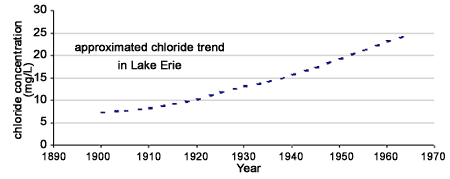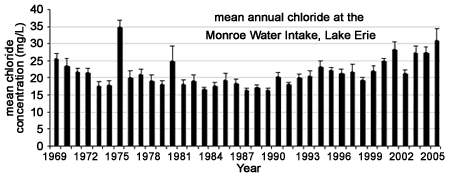Detroit River-Western Lake Erie Basin Indicator Project
Chloride Levels in Western Lake Erie Water Samples Collected from the Monroe Water Intake
Background
Chloride is a salt compound resulting from the combination of the gas chlorine and a metal. Common chlorides include sodium chloride (NaCl) and magnesium chloride (MgCl2). Chlorine alone is highly toxic and is often used as a disinfectant. In combination with a metal such as sodium, it becomes essential for life. Small amounts of chlorides are required for normal cell functions in plants and animals.
Chlorides are not usually harmful to people; however, the sodium part of table salt has been linked to heart and kidney disease. Sodium chloride may impart a salty taste to water at 250 mg/L (see Secondary Drinking Water Regulations: Guidance for Nuisance Chemicals); however, calcium or magnesium chloride is not usually detected by taste until levels of 1,000 mg/L are reached. Public drinking water standards require chloride levels not to exceed 250 mg/L.
For many decades there has been concern for increasing chloride concentrations in Lake Erie (Beeton 1961; Thomas 1981). Increased chloride concentrations may have caused changes in the biota of the Great Lakes, particularly halophytic (i.e., salt loving) algae such as Bangui atropurpurea (Sonzogni et al. 1983). The chloride concentration of Lake Erie is more than three times that of Lake Huron (Beeton et al. 2002). This is the result of Lake Erie's shallowness and relatively small water volume, combined with significant urban and industrial areas that are sources of chloride.
All municipal water intakes routinely monitor the quality of their water supplies. The Monroe Water Intake has continuously monitored its water supply since 1969. The intake structure is located 1,524 meters offshore in western Lake Erie and draws from a depth of 4.9 meters.
Status and Trends
Lake Erie chloride concentrations increased from about 7-8 mg/L in the early 1900s to approximately 25-30 mg/L in the 1960s (Figure 1; Beeton 1969). Since the late 1960s, continuous chloride monitoring has been performed at the Monroe Water Intake. In general, there has been high seasonal and year-to-year variability (Whyte et al. 1990). Whyte et al. (1990) found that between 1968 and 1985 there was a slight decreasing chloride trend at the Monroe Water Intake. This slight decreasing trend is due to reduced loadings from point source discharges and the cessation of certain industrial operations that historically discharged high chloride loadings. Further, U.S. Environmental Protection Agency's Great Lakes National Program Office has reported that mean, lake-wide chloride concentrations in Lake Erie have declined from approximately 20 mg/L in 1975 to 14 mg/L in 2000.

Figure 1. Changes in Lake Erie chloride concentration, 1900-1965, as reported by Beeton (1969) (chloride concentration trend approximated from Beeton, 1969).
Crucil et al. (1991) further investigated this decreasing trend and found that five of the six major industrial point sources in the Detroit River (Detroit River accounts for 94% of the inflow to Lake Erie), which historically contributed high chloride loadings, had ceased certain operations. The combined chloride loadings from these five industrial facilities decreased from an apparent high of 4,681 tons/day in 1964-1966 to zero in 1986, when the last of the five industrial facilities closed. Each of these facilities was involved in two specific industrial processes, which characteristically discharged large amounts of chloride: the production of soda ash by the Solvay method and the production of various inorganic chemicals by chlor-alkali methods. Reduced chloride loadings occurred from voluntary stipulations, cessation of these operations, and indirect regulatory controls.
Chloride concentrations in water samples from the Monroe Water Intake remain below state regulatory standards. However, from the late 1980s to the early 2000s there appears to be a slight increase in chloride levels in water samples collected from the Monroe Water Intake (Figure 2). Further monitoring will be required to confirm this trend. Average chloride concentrations in four of the last five years have been approximately 27-31 mg/L.

Figure 2. Mean annual chloride concentrations, including standard deviations, in raw water intake samples collected from western Lake Erie by the Monroe Water Intake, 1969-2005 (data provided by Gregory S. Allen, Superintendent, Monroe Water Filtration Plant; statistical support provided by Lisa Perschke, Emily Wilke of University of Michigan, Richard Hug of Indiana University N.W., and Don Busek of Belleville, Michigan).
Management Next Steps
Industrial process changes and the cessation of certain industrial operations have resulted in substantial reductions in point source (i.e., a specific or fixed point where pollution enters a stream or lake – an identifiable location such as an industrial discharge) chloride loadings to western Lake Erie. As the relative contribution of point source loadings of chloride has decreased, the relative contribution of nonpoint source (i.e., diffuse sources of pollution, such as runoff from precipitation, that do not enter a river or lake at a fixed point) loadings of chloride has increased. Holland et al. (1995) have shown that the annual chloride loading to Lake Erie is presently from diffuse sources (e.g., agricultural runoff, highway deicing, sheet and gully erosion, and stream bank erosion) and that maximum loading to the lake occurs during spring runoff and episodically during severe storms. As human population density in the Detroit River-Western Lake Erie watershed and urban sprawl increase, it is likely that road salt usage will increase. Thus, any efforts to stop or slow the apparent increasing chloride trend will require controlling of these nonpoint sources, such as road salting.
Considerable effort is being made by public works departments and transportation departments at all levels to improve the management of road salts. Some departments are well advanced with the introduction of technologies such as electronic spreader controllers, anti-icing, pre-wetting, and road weather information systems, whereas others are just beginning to investigate best management practices. The assessment of road salting impacts has led to a heightened interest in use of best management practices for road salting throughout the Great Lakes Basin.
Research/Monitoring Needs
Continued monitoring of chloride levels by municipal water intakes like Monroe, Michigan is warranted to track long-term trends. Efforts should also be made to quantify chloride loadings associated with road salting and other nonpoint sources. Further, biological monitoring should be enhanced (particularly phytoplankton) to document ecological changes associated with any further increases in chloride concentration in Lake Erie.
References
- Beeton, A.M. 1961. Environmental changes in Lake Erie. Trans. Am. Fish. Soc. 90: 152-159.
- Beeton, A.M. 1969. Changes in the environment and biota of the Great Lakes. In, Eutrophication: Causes, Consequences, Correctives. G.A. Rohlich (Ed.), pp. 150-187, National Academy of Sciences, Washington, D.C.
- Beeton, A.M., C.E. Sellinger, and D.F. Reid. 2002. An introduction to the Laurentian Great Lakes Ecosystem. In, Great Lakes Fisheries Policy and Management. C.P. Ferreri and W.W. Taylor (Eds.), pp. 3-54, Michigan State University Press, East Lansing, Michigan.
- Crucil, C., L. McGee, and J.H. Hartig. 1991. Why have Lake Erie Chloride concentrations decreased? Canadian Water Resources Journal. 16(1): 97-102.
- Holland, R.E., T.H. Johengen, and A.M. Beeton. 1995. Trends in nutrient concentrations in Hatchery Bay, Western Lake Erie, before and after Dreissena polymorpha. Canadian Journal of Fisheries and Aquatic Sciences. 52: 1202-1209.
- Sonzogni, W.C., W. Richardson, P. Rodgers, and T.J. Monteith. 1983. Chloride pollution of the Great Lakes. Water Poll. Control Fed. 55: 513-521.
- Thomas, N.A. 1981. Ecosystem changes in Lakes Erie and Ontario. Bull. Buffalo Soc. Nat. Sci. 25: 1-20.
- Whyte, R.S., J.H. Hartig, and G.J. Hopkins. 1990. Decreasing chloride trends observed at Lake Erie municipal water intakes. Great Lakes Res. 16(2): 233-240.
Contact Information regarding Chloride Levels in Western Lake Erie Water Samples Collected from the Monroe Water Intake
John H. Hartig, Refuge Manager
Detroit River International Wildlife RefugeE-mail: mailto:John_Hartig@fws.gov
Lisa Perschke
Washtenaw County Conservation DistrictAmeriCorps Groundwater Educator
E-mail: lisa.perschke@mi.nacdnet.net